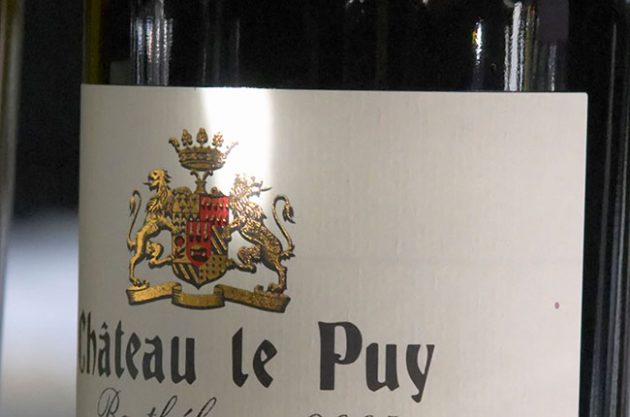
Anson: Tasting 100 years of wine at Bordeaux’s Château Le Puy
This is surely one of Bordeaux’s most overlooked wine estates, writes Jane Anson after tasting vintages spanning the past century at Château Le Puy, owned by the same family for more than 400 years and a firm believer in biodynamics.
1917. France is at war. Battles are raging along the Front and the French are tired and worried. In the countryside, women take on the work of the men alongside their own because the vine continues to grow regardless of the noise of the canons.
Far from these sufferings… at Château le Puy, hidden away near the hillsides of Pomerol and St-Emilion, life is peaceful. Joseph, the eldest son, is 21 and enlists in nearby Perigueux. The youngest Pierre Robert isn’t quite six years old. He will become the 12th generation winemaker at the château, but at the time is simply a nervous little boy who is frequently unwell.
This is taken from the booklet accompanying one of the most remarkable tastings that I have been to this year – a century of wine from Château le Puy, an estate located at pretty much the highest spot of Francs Côtes de Bordeaux.
Although records of the Amoreau family making wine at the property date back to 1610, Le Puy isn’t a prestigious name and its appellation is one that has won little acclaim.
‘If you want proof that there are overlooked terroirs in Bordeaux, here it is.’
The château has never been classified, and is made with almost 100% Merlot, a grape that outside of the famous clays of Pomerol or the buttoned-up limestones of the St-Emilion plateau is not supposed to go the distance.
And yet the earliest vintages of Château Le Puy’s cuvée Emilien wine (the biggest production of the estate) that we tasted here – the 1917, the 1926 and particularly the 1936 – were still humming with life.
There is a strand of freshness, salinity and purity that runs clean through the century of wines that are lined up for us in the Salon Versailles of Le Bristol hotel, Paris; a place that opened eight years after our first bottle, in 1925.
If you want proof that there are overlooked terroirs in Bordeaux, here it is.
You might have heard of Le Puy if you are a fan of the Japanese manga The Drops of God, that in 2009 acclaimed its 2003 vintage and called it a ‘miracle wine… produced for 400 years without a drop of pesticide’. Or fans of appellation politics might remember it being refused the right to its local AOC on several occasions for being ‘atypical’ of the area.
Owner Jean-Pierre Amoreau is pretty proud of that one, and has been battling for his own appellation for one particularly distinctive part of his vineyard since 2011, so far without success.
In the meantime, he makes the wine according to his own quality charter, which instructs biodynamic farming (Demeter certified) and the presence of one hectare of hedgerows or wild flowers for every hectare of vines.
Sulphur additions are kept either minimal or non-existent, vinification is open topped for much of the process and the wine is aged in five to 40-year old oak barrels for 24 months or longer. They are currently moving towards permaculture (or ‘do-nothing farming’), basing their work on the writings of the celebrated Japanese farmer-philosopher Masonobu Fukuoka.
Le Puy’s Emilien, as you might be able to gather from all of this, is a wine full of personality, and so one that is perfectly suited to the kind of slow appreciation that a century overview can provide.
I have attended a few of these 100 Year Overviews in recent years – one of Château Canon held in Place Vendôme, so not too far from here, and another of Château Siran held at the estate back in Margaux. Each time they provide an amazing way to inch your way towards the understanding of a wine and its wider context.
And this one has an added extra for an information junkie like me. Honestly, every tasting booklet should go to this level of detail. We are given not just extensive wine data from yield, alcohol, total acidity and added sulphur but detailed climatology for per month of each year, including average rainfall and over how many days it fell, sunshine and temperature plus the number of days of hail, frost and storms.
Once the tasting is done, it’s fun to try to make sense of these little clues as to how they shaped the results in the glass.
Historical notes are also given where relevant – the 1944, for example, was made by Paule Amoreau while her husband Robert was away during the war, an example of history repeating itself from the winemaking during World War One.
In total we tasted 24 vintages, and I am picking here my favourite 12 wines that told me something about the estate, the family and the time in which it was made. It’s worth taking a step back to consider how many wines from the Côtes de Bordeaux would be willing to put a century of wines on public display? And how many would prove this pleasurable an experience?
What is clear is that Le Puy is an inspiring château that kicks against the usual definitions of Right Bank Bordeaux.
They are not afraid of low alcohols here, and again and again the highest yields seems to crop up alongside the best vintages – 63hl/h in 2010 compared to 20hl/h in 2008 for example – proving once again that Le Puy defies long-held beliefs in its technical sheets as it does in so much else.
Exclusively for Decanter Premium members:
Jane Anson’s favourite 12 Le Puy wines from this tasting:
